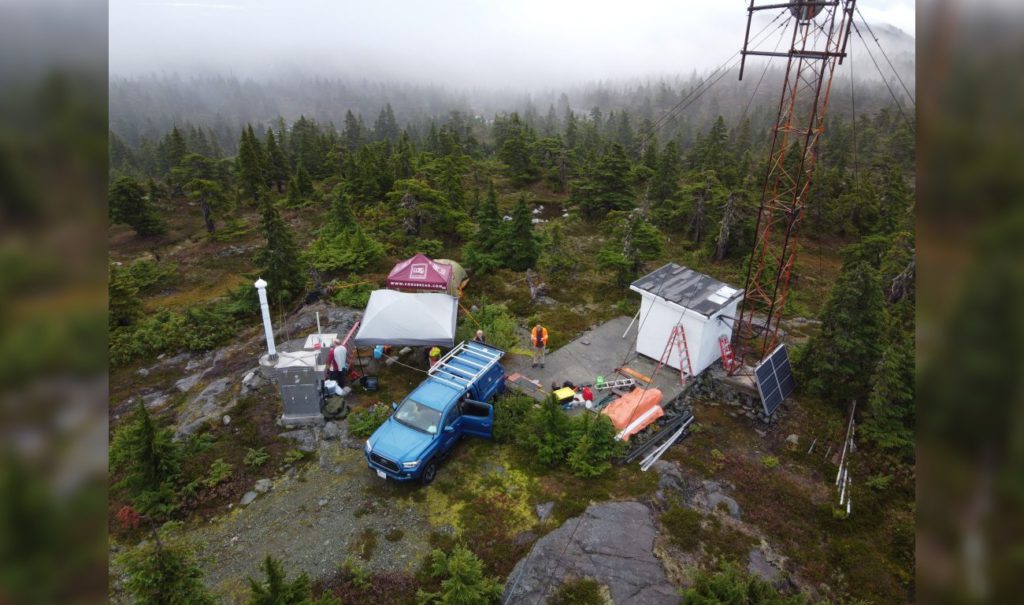
Nestled across the many mountain peaks of Vancouver Island, an amateur radio system serves as a crucial communication link from Victoria all the way to Port Hardy.
For over 30 years, the Island Trunk System has served as a lifeline for those out of cell service and as a network for emergency communications in the event of a calamity.
It’s a series of radio repeaters that can carry the signal from a low-powered handheld device all the way across Vancouver Island.
Most might not see the benefit of such a system, especially when in this day and age everyone has a cell phone that can dial anyone, anywhere.
However, there’s a group of impassioned hobbyists who stand by the technology and boast its capabilities.
Across B.C., they operate on behalf of Emergency Management B.C. and volunteer their time as amateur radio operators, carrying out programs like the one on Vancouver Island known as the Capital Regional Emergency Radio Coordinators Committee.
Every Wednesday, at 7:30 p.m., they get on the air and practice with the system to hone their ability for the day they might have to use it.
The initiative is a true testament to the power of community and collaboration, with each area of the Island having its own dedicated equipment and volunteer group.
“Strictly speaking, each amateur radio club on Vancouver Island has the responsibility for the repeaters in their community,” said Chris Anton, treasurer for the Nanaimo Amateur Radio Association.
These volunteers mainly operate the network out of dedicated rooms within their local fire halls, city centres, or government buildings — but that’s not to say it can’t be utilized elsewhere.
In fact, the system operates year-round and those with their amateur licences are permitted to use it freely, provided they get their permit and abide by the rules set out by Innovation, Science and Economic Development Canada.
“If I’m down in a valley in Nanaimo, if I can connect to a radio repeater up on the top of Mount Brenton, I can be talking to someone in the Cowichan Valley … which is something we wouldn’t be able to do if we just had our individual radios,” said Anton.
For the most part, he says that the radio repeaters work within line of sight, which is why they’re put on top of mountains.
The radio system is made up of roughly 14 repeater stations across the Island. Most of the equipment has been donated, salvaged, or repurposed from old commercial facilities, making this a genuine community-driven initiative.
“If you want to talk even further, you have to tie one repeater to another repeater, to another repeater site, to yet another repeater site. So if you’re down in Victoria, with your handheld, you can talk to that repeater that’s up on Mount Brenton, close to Chemainus. The advantage is Mount Brenton is 4700 feet high, so it has huge coverage. All across the south end of the Island, to the Gulf Islands, down into Washington State.”
Up and down the Island, countless hours of work go into maintaining the system. From upgrading the equipment to training new members and working alongside municipalities and the province to flesh out emergency preparedness programs, there’s no shortage of tasks.
Anton estimates that it took an estimated 300 man-hours for several volunteers to carry out a multi-day project to upgrade their repeater site on Newcastle Ridge. Members from the various groups chipped together to rent a crane truck that they could drive to the mountain peak and use to upgrade the antenna.
- Courtesy of Chris Anton
The next big escapade the HAMs have planned will take place this August. Members from the various groups across the Island will get together for 3-4 days of work. They plan to travel up Island to Port McNeill and replace a worn-out roof at one of their radio repeater relay sites.
While the Island Trunk System is used regularly for day-to-day communication needs, its true value is best demonstrated in moments of crisis.
In 2020, a man from Qualicum Beach faced a dire situation when he couldn’t reach his phone inside his burning house. However, he did have a radio in his car that let him cast a call for help over the Island Trunk System which was ultimately answered.
“We were woken up at 4 a.m. by an explosion that shook the house,” wrote Steve Goyette. “Jumping out of bed my wife and I ran downstairs and it was quickly evident that there was a fire in my office.”
He says that he had forgotten to grab his cellphone during the rush to get his family out of the burning building. By the time he realized, it was too dangerous to go back and get it.
“Fortunately I have HAM radios in all of our vehicles and the truck was unlocked. I tuned to our local repeater, which was linked all across Vancouver Island, and started calling emergency.”
He says he was lucky there were several people listening.
“The fire department was quickly dispatched and arrived within 15 minutes.”
It’s not clear what Goyette could have done if no one had answered his call that day. Thankfully, he’ll never know — as long as there are amateur radio operators on Vancouver Island who are willing to step up and provide emergency communication services, we can take comfort in the fact that they’re ready to help.
These groups are constantly seeking new members to join their ranks, and chances are there is one in your area.
From Victoria to Port Hardy, there is bound to be someone on the air. ’73.

A map of the Island Trunk System, from 2019. | Courtesy of NIARA
RELATED: Sooke, Port Renfrew cell tower infrastructure upgrades completed






